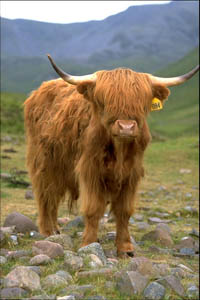United Nations-measured-flatulence
Scientists sniffing out methane emissions from cows sniffing at the wrong end
By Judi McLeod
Wednesday, July 11, 2007
In the feverish race to cut methane emissions, agricultural bureaucrats have spent millions of dollars studying the wrong end of cattle and sheep.
It's the burp and not United Nations-measured-flatulence sending greenhouse gas pollution sky high.
"Farmed ruminant animals are thought to be responsible for up to a quarter of "man-made" methane emissions worldwide though contrary to common belief, most gas emerges from their front, not rear, ends." (The Guardian, July 10, 2007).
But while British experts have managed to pull their heads from the rear ends of cows and sheep, their North American counterparts are still there.
 No one knows who ratted out the stinky cattle and sheep of the meadows to the MYOB-challenged (Mind Your Own Business –Challenged) UN and Al Gore.
No one knows who ratted out the stinky cattle and sheep of the meadows to the MYOB-challenged (Mind Your Own Business –Challenged) UN and Al Gore.
Generations of motorists driving on country roads considered the bad smells coming from the pasture as natural as summer rains.
But late last month, the United States Department of Agriculture rewrote age old Mother Nature. It released reports stating that when you smell cow manure, you're also (God forbid) smelling greenhouse gas emissions.
And you can bet the family farm that when the DOA comes up with an idea, it's going to cost taxpayers money.
Odiferous cow manure, now the focus of millions of dollars worth of research, must be stamped out wherever it's found.
"Agriculture Under Secretary for Natural Resources and Environment, Mark Rey, was in Corning Wednesday morning at the Big Flats Plant Materials Center to announce the award of nearly $20 million in Conservation Innovation Grants to fund 51 research projects across the country designed to refine new technologies helping dairy and other agricultural producers cut back on their greenhouse emissions and cash in on governmental incentives for the research." ( www.wetmtv.com, June 28, 2007).
A cool million dollars of those grants were earmarked specifically for New York State.
The USDA is currently taking applications from large dairy farms across the state that want to participate.
When Mark Rey goes off sniffing, it can get very expensive for taxpayers.
Here's the deal: "The main focus of the grant-funded research in New York State would be to tarp off areas where farmers dump cow manure, commonly called manure lagoons. Researchers would then prevent those gases from entering the atmosphere, measure how many units are produced, and farmers would receive cash incentives, called "Carbon Credits," for each unit produced. They would also receive annual payments for use of their properties.
As Rey puts it: "It helps them (farmers) meet some environmental regulatory requirements, and at the same time helps them generate more income."
You'd think with all the tainted foods coming in from China that American farmers would be encouraged to grow more crops.
Dairy farmer Dave Boor says his small, 100-cow operation in Horseheads is hit hard every year with costly environmental regulations he has had a hard time affording.
Boor says he hopes the new research will shed light on the issue, perhaps finding that small farms shouldn't have to face the same regulations larger farms do.
"In many cases with some of the smaller farms where maybe it isn't significant, perhaps some of these mandates won't be pushed on the small farmers that are already teetering on the bank of closing down," said Boor.
Still processing applications, the USDA can accept up to eight dairy farms for participation in the research across New York State.
Not only does overseas evidence say that scientists are at the wrong end of cattle and sheep, the United States Department of Agriculture could have saved $20 million by checking in with their Canadian counterpart.
Heading into their research already knowing that "agriculture contributes 10 to 13 percent of Canada's greenhouse gas emissions", Canada's federal government continue their research at the wrong end.
The belching and flatulence of cows is an obsession for Canada's Agriculture Department, which is jokingly called the "belching and flatulence" directorate.
"That's where civil servants spend countless hours--and tax dollars--capturing and analyzing animal burps and farts," Ezra Levant wrote in his book, Fight Kyoto.
Ottawa mandarins refer to it as "livestock emissions"--emissions from animals and their manure that make up some 20 megatonnes of greenhouse gases each year.
The mandarins have greenhouse emissions coming from the pasture down to a fine science.
The government has an official website called ManureNet to track livestock emissions--in both official languages.
The experiments of the Canadian government on greenhouse gas emissions from Bessie the Cow suggest that cattle should take drugs to stop passing gas.
According to this study, dairy cows that had an additive called monensin mixed into their diets tooted up to 28 per cent less--a fact borne out by scientists who claim to have actually measured it.
Other scientist-launched ideas to make cattle less flatulent include pumping cattle full of anti-flatulence hormones, such as Bovine Somatotropin, which cut down on methane emissions by nine per cent.
Meanwhile, proverbial cows eventually come home, but as long as grant dollars for fixing methane emissions are available, some scientists never will.
Canada Free Press founding editor Most recent by Judi McLeod is an award-winning journalist with 30 years experience in the print media. Her work has appeared on Newsmax.com, Drudge Report, Foxnews.com, Glenn Beck. Judi can be reached at: judi@canadafreepress.com
Pursuant to Title 17 U.S.C. 107, other copyrighted work is provided for educational purposes, research, critical comment, or debate without profit or payment. If you wish to use copyrighted material from this site for your own purposes beyond the 'fair use' exception, you must obtain permission from the copyright owner. Views are those of authors and not necessarily those of Canada Free Press. Content is Copyright 1997-2024 the individual authors. Site Copyright 1997-2024 Canada Free Press.Com Privacy Statement